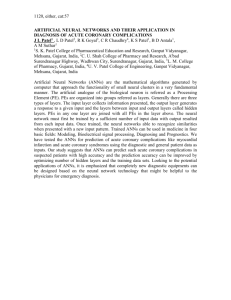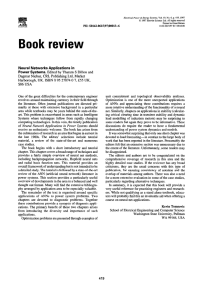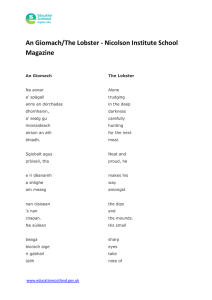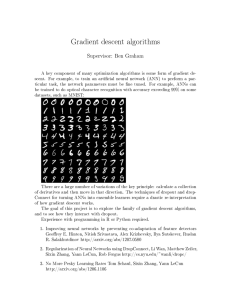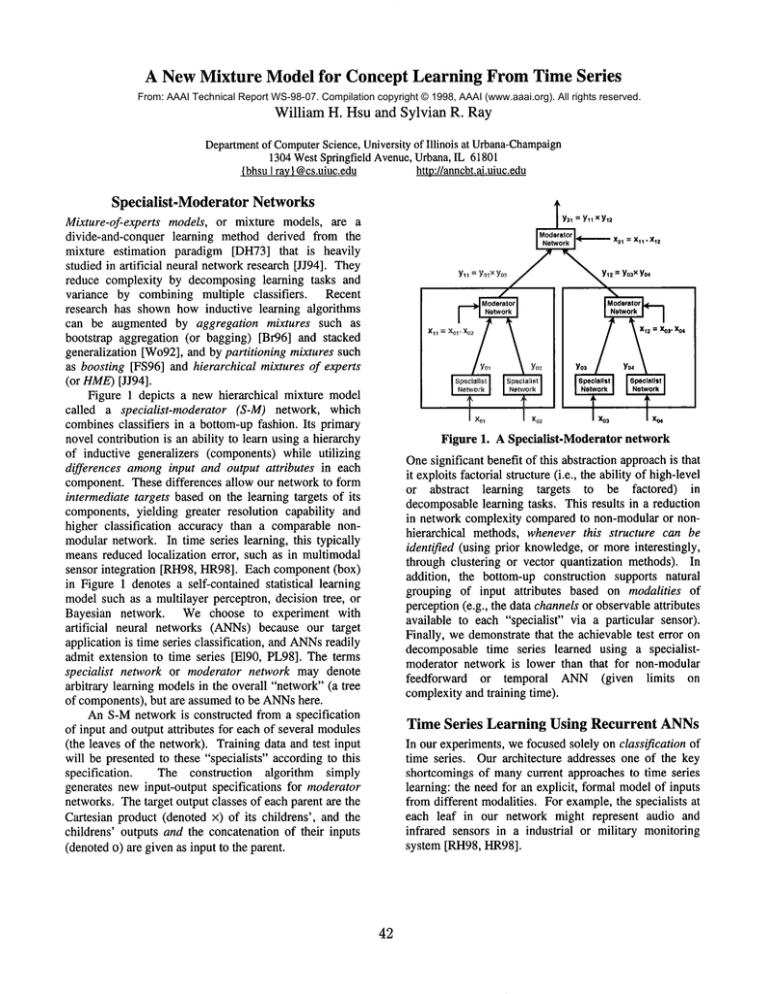
A New Mixture Model for Concept Learning FromTime Series
From: AAAI Technical Report WS-98-07. Compilation copyright © 1998, AAAI (www.aaai.org). All rights reserved.
William H. Hsu and Sylvian
R. Ray
Departmentof Computer
Science, Universityof Illinois at Urbana-Champaign
1304WestSpringfield Avenue,Urbana,IL 61801
{bhsuI ray} @cs.uiuc.edu
http://anncbt.ai.uiuc.edu
Specialist-Moderator
Networks
~
Mixture-of-experts models, or mixture models, are a
divide-and-conquer learning method derived from the
mixture estimation paradigm [DH73] that is heavily
studied in artificial neural networkresearch [JJ94]. They
reduce complexity by decomposing learning tasks and
variance by combining multiple classifiers.
Recent
research has shown how inductive learning algorithms
can be augmented by aggregation mixtures such as
bootstrap aggregation (or bagging) [Br96] and stacked
generalization [Wo92],and by partitioning mixtures such
as boosting [FS96] and hierarchical mixtures of experts
(or HME)[J J94].
Figure 1 depicts a new hierarchical mixture model
called a specialist-moderator
(S-M) network, which
combinesclassifiers in a bottom-up fashion. Its primary
novel contribution is an ability to learn using a hierarchy
of inductive generalizers (components) while utilizing
differences amonginput and output attributes in each
component. These differences allow our network to form
intermediate targets based on the learning targets of its
components, yielding greater resolution capability and
higher classification accuracy than a comparable nonmodularnetwork. In time series learning, this typically
meansreduced localization error, such as in multimodai
sensor integration [RH98, HR98]. Each component(box)
in Figure 1 denotes a self-contained statistical learning
modelsuch as a multilayer perceptron, decision tree, or
Bayesian network. We choose to experiment with
artificial
neural networks (ANNs)because our target
application is time series classification, and ANNs
readily
admit extension to time series [El90, PL98]. The terms
specialist network or moderator network may denote
arbitrary learning modelsin the overall "network"(a tree
of components), but are assumedto be ANNshere.
An S-Mnetwork is constructed from a specification
of input and output attributes for each of several modules
(the leaves of the network). Training data and test input
will be presented to these "specialists" according to this
specification.
The construction algorithm simply
generates new input-output specifications for moderator
networks. The target output classes of each parent are the
Cartesian product (denoted ×) of its childrens’, and the
childrens’ outputs and the concatenation of their inputs
(denotedo) are given as input to the parent.
Y’I1
= ~#0, X ’,’~
Y-~
/
[ XU2
= Y~Ix Y~2
X21 = Xll oxt2
"~12 = Yo3X Y04
I X03
I X04
Figure 1. A Specialist-Moderator network
Onesignificant benefit of this abstraction approachis that
it exploits factorial structure (i.e., the ability of high-level
or abstract learning targets to be factored) in
decomposablelearning tasks. This results in a reduction
in network complexity compared to non-modular or nonhierarchical methods, whenever this structure can be
identified (using prior knowledge,or more interestingly,
through clustering or vector quantization methods). In
addition, the bottom-up construction supports natural
grouping of input attributes based on modalities of
perception (e.g., the data channelsor observableattributes
available to each "specialist" via a particular sensor).
Finally, we demonstrate that the achievable test error on
decomposable time series learned using a specialistmoderator network is lower than that for non-modular
feedforward
or temporal ANN(given limits on
complexityand training time).
Time Series
Learning
Using Recurrent
ANNs
In our experiments, we focused solely on classification of
time series. Our architecture addresses one of the key
shortcomings of manycurrent approaches to time series
learning: the need for an explicit, formal modelof inputs
from different modalities. For example, the specialists at
each leaf in our network might represent audio and
infrared sensors in a industrial or military monitoring
system [RH98, HR98].
42
Comparison with HME
As Table 2 shows, an HMEnetwork with 8 leaves
outperforms one with 4 and is comparable to the
specialist-moderator network of feedforward networks. It
is, however, outperformed by the specialist-moderator
network of input recurrent networks. This is significant
because incorporating recurrence into HMErequires
nontrivial modificationsto the algorithm.
ill
Fectorizationby
Frequencyand Rhythm
7F
Simple (Non-Modular)
Artificial NeuralNetwork
41F
16C= 41r x
n 41
2R
41R
t
Specialist-Moderator
Network
ili
7F o 2R
Figure 2. Musical tune classification
.......
.....
Table 2. Specialist-Moderator network versus HME
problem
Conclusions and Future Work
Figure 2 depicts non-modular and specialist-moderator
architectures for learning a musical tune classification
database with 89 tunes and 16 target classes. The nonmodular network receives 9 channels of input and is
trained using a locally coded target [K J97] for the prelabeled tunes. The first-level (leaf) networks in the
specialist-moderator network receive specialized inputs:
the frequency component only or the rhythm component
only. The principle is that only the frequency component
is relevant to the frequency specialist, and similarly for
rhythm. The targets are intermediate attributes IF and IR.
Weused competitive clustering by Gaussian radial-basis
functions (RBFs) to demonstrate that IF and IR could be
formed, by unsupervised learning,
for a 4-by-4
factorization, amongothers [RH98].
Wehave presented an algorithm for combiningdata from
multiple input sources (sensors, specialists with different
concentrations, etc.) and a modular,recurrent, artificial
neural network for time series learning. Fusion of time
series classifiers showcasesthe strengths of our mixture
modelbecause there are manypreprocessing methods that
produce reformulated input. Typical applications are
process monitoring, prediction, and control [HR98].
References
[Br96] L. Breiman. Bagging Predictors.
Machine
Learning, 1996.
[DH73]R. O. Dudaand P. E. Hart. Pattern Classification
and Scene Analysis. Wiley, NewYork, NY,1973.
[El90] J. L. Elman. Finding Structure in Time. Cognitive
Science, 14:179-211, 1990.
[FS96] T. Freund and R. E. Schapire. Experiments with a
NewBoosting Algorithm. In Proceedings oflCML-96.
[Hs97] W. H. Hsu. Spatiotemporal Sequence Learning
With Probabilistic
Networks. Unpublished, URL:
http://anncbt.ai.uiuc.edu/prelim.doc, 1997.
[HR98] W. H. Hsu and S. R. Ray. A NewMixture Model
for Concept Learning From Time Series. Extended
abstract, http://anncbt.ai.uiuc.edu/hr98a.ps, 1998.
[JJ94] M. I. Jordan and R. A. Jacobs. Hierarchical
Mixtures of Experts and the EMAlgorithm. Neural
Computation, 6:181-214, 1994.
[K J97] R. Kohavi and G. H. John. Wrappersfor Feature
Subset Selection. Artificial Intelligence, Special Issue on
Relevance, 97(1-2):273-324, 1997.
[PL98] J. Princip6, C. Lefebvre. NeuroSolutions v3.01,
NeuroDimension,Gainesville, FL, 1998.
[RH98]S. R. Ray and W. H. Hsu. Modular Classification
for Spatiotemporal Sequence Processing. Submitted to
Journalof lntelligent DataAnalysis.
[Wo92]D. H. Wolpert. Stacked Generalization. Neural
Networks, 5:241-259, 1992.
Comparison With Non-Modular ANNs
Table 1 shows the performance of the non-modular
(simple feedforward, or FF, and input recurrent, or IR
[PL98]) ANNscompared to their specialist-moderator
counterparts. The italicized networkshave 16 targets; the
specialists, 4 each. Prediction accuracy is measuredby
the numberof individual exemplarsclassified. The results
illustrate that input recurrent networks(simple, specialist,
and moderator) are more capable of generalizing over the
temporally coded music data than are feedforward ANNs.
534/589 (90.66%) 104/128 (81.25%)
I FF, Frequency / 589/589 (100.0%) [ 128/128 (100.0%)
!~’........°~"~"":"~:*~:~"~’~’~
~": ii!!~ii!~
~~i~ii~iii~
!~:~’~:
’:’~’~’ ""~"~~""~7,....:~.:~:~.~......,..,~.....~.,,.., ..~.-~-. ,,~,,,~,,,:
IR, Simple
566/589(96.10%) 83/128(64.84%)
[ IR, Rhythm
I 565/589(95.93%) I 107/128(83.59%)
I IR, Frequency ] 589/589(100.0%) I 128/128(100.0%)
Table 1. Modularversus non-modular networks
43


